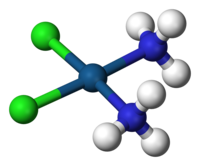
Photo from wikipedia
High concentrations of active carriers on the surface of a semiconductor through energy/electron transfer are the core process in the photocatalytic hydrogen production from water. However, it remains a challenge… Click to show full abstract
High concentrations of active carriers on the surface of a semiconductor through energy/electron transfer are the core process in the photocatalytic hydrogen production from water. However, it remains a challenge to significantly improve photocatalytic performance by modifying simple molecular modulation. Herein, a new strategy is proposed to enhance the photocatalytic hydrogen evolution performance using boron and nitrogen elements to construct B←N coordination bonds. Experimental results show that polynaphthopyridine borane (PNBN) possessing B←N coordination bonds shows a hydrogen evolution rate of 217.4 µmol h−1, which is significantly higher than that of the comparison materials 0 µmol h−1 for polyphenylnaphthalene (PNCC) and 0.66 µmol h−1 for polypyridylnaphthalene (PNNC), mainly attributed to the formation of a strong built‐in electric field that promotes the separation of photo‐generated electrons/holes. This work opens up new prospects for the design of highly efficient polymeric photocatalysts at the molecular level.
Journal Title: Advanced Science
Year Published: 2022
Link to full text (if available)
Share on Social Media: Sign Up to like & get
recommendations!